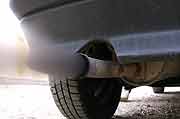
WEDNESDAY, March 4, 2015 (HealthDay News) — Children in southern California may be breathing easier these days compared with the 1990s, thanks to a big reduction in air pollution, a new study suggests.
Researchers found that as air quality improved in five Los Angeles-area communities over two decades, so did children’s lung development.
Experts said the findings, published in the March 5 issue of the New England Journal of Medicine, suggest a major public health benefit from cleaner air: Kids’ lung function not only matters in the short-term, but is also tied to their risk of developing heart and lung disease later in life.
The results are welcome news, said study leader W. James Gauderman, a professor of preventive medicine at the University of Southern California, Los Angeles.
But, he said, they are not an indicator that the nation’s work is done when it comes to air quality.
“There’s a cautionary note,” Gauderman said. Urban areas are growing, and the economy is picking up, he noted — which adds up to more traffic in cities, more trucks on the highways, busier seaports and more industrial activity.
“If emissions from those sources remain the same, we could lose some of the gains we’ve seen in air quality,” Gauderman said.
So there’s still plenty of room, he added, for “cleaner” cars and fewer emissions from power plants and other industrial sources.
The findings are based on three different groups of children who had their lung function tested repeatedly between the ages of 11 and 15 — a critical period for lung development.
All were from the same five communities near Los Angeles, but were tested at different time periods: 1994-1998, 1997-2001, or 2007-2011.
Gauderman’s team found that children in the 21st century group had stronger gains in lung function by age 15, versus kids from the two earlier periods.
The improvements paralleled sharp reductions in local levels of some major air pollutants, including nitrogen dioxide and fine particulate matter — which dropped by about 40 percent over the study period.
Motor vehicles and industrial sources contribute to both pollutants, Gauderman noted.
How significant were the improvements in kids’ lung function over time?
“One of our most important findings,” Gauderman said, “was that the percentage of children with abnormally low lung function at age 15 declined from nearly 8 percent, to less than 4 percent in the most recent [group].”
Beyond that, kids’ lung development has lifelong implications, according to Douglas Dockery, chair of the environmental health department at the Harvard School of Public Health, in Boston.
“Your lungs grow until your late-teens or early-20s,” said Dockery, who co-wrote an editorial published with the study. “What you have when you reach maturity is the best you’re going to have.”
And there is a link between that early lung development and the risk of developing heart or lung disease decades later, Dockery said.
Gauderman made the same point. “If these improvements [in lung function] carry through to adulthood, we would expect to see a reduction in their lifetime risks of cardiovascular disease and respiratory disease,” he said.
A combination of local, state and federal regulations has been credited with driving down pollution in the once smog-veiled Los Angeles “basin.” It might sound logical that kids’ lung function would improve, but scientific evidence of that has been lacking — partly because such studies are hard to do, according to Dockery.
He said other studies have found that kids who live in “dirtier cities” tend to have more asthma and worse lung function. But it’s difficult to rule out other factors that make communities different from one another.
This study, Dockery said, charted improvements within communities.
“We want to establish public policies that actually work,” he said. “The argument for air-quality regulations has been that we expect to see health benefits. What’s exciting about this study is, it gives us solid evidence.”
And while the study focused on the Los Angeles area, both Dockery and Gauderman said it’s reasonable to expect that kids’ lung health has benefited in any U.S. community that has made similar improvements in air quality.
Still, Dockery agreed that the positive message should be tempered. “Yes, we should congratulate ourselves on making progress, but we don’t want to backslide, either,” he said. “And there are certainly people still living in polluted areas. We can’t forget that.”
More information
The U.S. Environmental Protection Agency has more on air-pollution control and health.
Copyright © 2025 HealthDay. All rights reserved.

